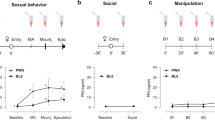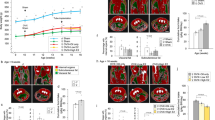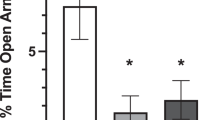Abstract
ENDORPHINS, the endogenous peptides recently isolated and identified in brain have been implicated in regulation of pain1–4. But their wide distribution throughout the brain5–7 and their profound behavioural effects after central administration8 suggest an involvement in other central nervous system processes. Immunohistochemical identification of these endorphins (refs 9, 10 and F. Bloom, personal communication) in hypothalamic neurones indicated that neuroendocrine effects are probable. Morphine was previously reported to block ovulation, while more recently, morphine11 and endorphins12–14 were observed to stimulate release of prolactin and growth hormone. Yet, these observations have not established a direct, tonic participation of endorphins in hypothalamic and anterior pituitary function. The absence of any direct action of opiate antagonists has been taken as an argument against any tonic role of endorphins. Recent reports indicate, however, that opiate antagonists do modify on-going central processes. For example, naloxone and naltrexone lower pain threshold in appropriate conditions in man and experimental animals15–18. Using naltrexone as a tool to block opiate receptor function, we have explored whether endorphins are tonically involved as a putative neurotransmitter in the regulation of prolactin release. The results presented here demonstrate a new instance where an opiate antagonist modifies normal function. The data agree with a preliminary report indicating that naloxone reduced prolactin release in immature female rats19.
This is a preview of subscription content, access via your institution
Access options
Subscribe to this journal
Receive 51 print issues and online access
$199.00 per year
only $3.90 per issue
Buy this article
- Purchase on Springer Link
- Instant access to full article PDF
Prices may be subject to local taxes which are calculated during checkout
Similar content being viewed by others
References
Loh, H. H., Tseng, L. F., Wei, E. & Li, C. H. Proc. natn. Acad. Sci. U.S.A. 78, 2895–2898 (1976).
Hughes, J. et al. Nature 258, 577–579 (1975).
Ling, N. & Guillemin, R. Proc. natn. Acad. Sci. U.S.A. 73, 3308–3310 (1976).
Belluzzi, J. D. et al. Nature 260, 265–266 (1976).
Simantov, R. & Snyder, S. H. in Opiates and Endogenous Opioid Peptides (ed. Kosterlitz, H.) 41–48 (Elsevier, Amsterdam, 1976).
Wahlstrom, A., Johansson, L. & Terenius, L. in Opiates and Endogenous Opioid Peptides (ed. Kosterlitz, H.) 49–56 (Elsevier, Amsterdam, 1976).
Yang, H.-Y., Hong, J. S. & Costa, E. Neuropharmacology 16, 303–307 (1977).
Bloom, F., Segal, D., Ling, N. & Guillemin, R. Science 194, 630–632 (1976).
Elde, R., Hokfelt, T., Johansson, O. & Terenius, L. Neuroscience 1, 349–353 (1976).
Simantov, R., Kuhar, M. J., Uhl, G. R. & Snyder, S. H. Proc. natn. Acad. Sci. U.S.A. 74, 2167–2171 (1977).
Ojeda, S. R., Harms, P. G. & McCann, S. M. Endocrinology 95, 1694–1703 (1974).
Rivier, C., Vale, W., Ling, N., Brown, M. & Guillemin, R. Endocrinology 100, 238–241 (1977).
Lien, E. L., Fenichel, R. L., Garsky, U., Sarantakis, D. & Grant, N. H. Life Sci. 19, 837–840 (1976).
Dupont, A., Cusan, L., Garon, M., Labrie, F. & Li, C. H. Proc. natn. Acad. Sci. U.S.A. 74, 358–359 (1977).
Akil, H., Mayer, D. J. & Liebeskind, J. C. Science 191, 961–962 (1976).
Mayer, D. J. Neurosci. Res. Program Bull. 13, 94 (1975).
Jacobs, J. J., Tremblay, E. C. & Colombel, M. C. Psychopharmacology, 37, 217–223 (1974).
Madden, J., Akil, H., Patrick, R. L. & Barchas, J. D. Nature 265, 358–360 (1977).
Shaar, C. J., Frederickson, R. C. A., Dininger, N. B., Clemens, J. A. & Hull, R. H. Fedn Proc. 36, 311 (1977).
Lazarus, L. H., Ling, W. & Guillemin, R. Proc. natn. Acad. Sci. U.S.A. 73, 2156–2159 (1976).
Bradburg, A. F., Smyth, D. G., Shepp, C. R., Birdsall, N. J. M. & Hulme, E. C. Nature 206, 793–794 (1976).
Li, C. H. & Chung, D. Proc. natn. Acad. Sci. U.S.A. 73, 1145–1148 (1976).
Dupont, A. et al. Fedn Proc. 36, 311 (1977).
Ferland, L., Fuxe, K., Eneroth, P., Gustafsson, J.-A. & Skett, P. Eur. J. Pharmac. 43, 89–90 (1977).
Halasz, B. & Pupp, L. Endocrinology 77, 553–562 (1965).
Konig, J. F. R. & Klippel, R. A. The Rat Brain (Krieger, New York, 1967).
Author information
Authors and Affiliations
Rights and permissions
About this article
Cite this article
GRANDISON, L., GUIDOTTI, A. Regulation of prolactin release by endogenous opiates. Nature 270, 357–359 (1977). https://doi.org/10.1038/270357a0
Received:
Accepted:
Issue Date:
DOI: https://doi.org/10.1038/270357a0
This article is cited by
-
Naltrexone effects on pituitary neurointermediate lobe and median eminence
Neurochemical Research (1984)
Comments
By submitting a comment you agree to abide by our Terms and Community Guidelines. If you find something abusive or that does not comply with our terms or guidelines please flag it as inappropriate.



